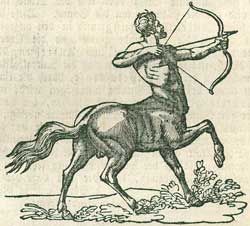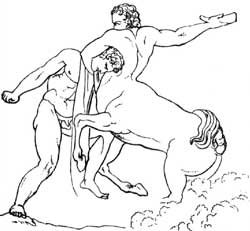centaur
That is, the "bullkillers," are according to the earliest accounts a race of men who inhabited the mountains and forests of Thessaly. They are described as leading a rude and savage life, occasionally carrying off the women of their neighbors, as covered with hair and ranging over their mountains like animals. But they were not altogether unacquainted with the useful arts, as in the case of Chiron.1
Now, in these earliest accounts, the centaurs appear merely as a sort of gigantic, savage, or animal-like beings; whereas, in later writers, they are described as monsters (hippocentaurs), whose bodies were partly human and partly those of horses. This strange mixture of the human form with that of a horse is accounted for, in the later traditions, by the history of their origin. Ixion, it is said, begot by a cloud Centaurus, a being hated by gods and men, who begot the hippocentaurs on Mount Pelion, by mixing with Magnesian mares.2 According to Diodorus,3 the centaurs were the sons of Ixion himself by a cloud; they were brought up by the nymphs of Pelion, and begot the hippocentaurs by mares. Others again relate, that the centaurs were the offspring of Ixion and his mares; or that Zeus, metamorphosed into a horse, begot them by Dia, the wife of Ixion.4 From these accounts it appears, that the ancient centaurs and the later hippocentaurs were two distinct classes of beings, although the name of centaurs is applied to both by ancient as well as modern writers.

The centaurs are particularly celebrated in ancient story for their fight with the Lapiths, which arose at the marriage-feast of Pirithous, and the subject of which was extensively used by ancient poets and artists. This fight is sometimes put in connexion with a combat of Heracles with the centaurs.5 The scene of the contest is placed by some in Thessaly, and by others in Arcadia. It ended by the centaurs being expelled from their country, and taking refuge on Mount Pindus, on the frontiers of Epeirus. Chiron is the most celebrated among the centaurs.
As regards the origin of the notion respecting the centaurs, we must remember, in the first place, that bull-hunting on horseback was a national custom in Thessaly,6 and, secondly, that the Thessalians in early times spent the greater part of their lives on horseback. It is therefore not improbable that the Thessalian mountaineers may at some early period have made upon their neighboring tribes the same impression as the Spaniards did upon the Mexicans, namely, that horse and man were one being.

The centaurs were frequently represented in ancient works of art, and it is here that the idea of then is most fully developed. There are two forms in which the centaurs were represented in works of art. In the first they appear as men down to their legs and feet, but the hind part consists of the body, tail, and hind legs of a horse;7 the second form, which was probably not used before the time of Phidias and Alcamenes, represents the centaurs as men from the head to the loins, and the remainder is the body of a horse with its four feet and tail.8
It is probably owing to the resemblance between the nature of the centaurs and that of the satyrs, that the former were in later times drawn into the sphere of Dionysiac beings; but here they appear no longer as savage monsters, but as tamed by the power of the god. They either draw the chariot of the god, and play the horn or lyre, or they appear in the train of Dionysus, among the satyrs, fauns (Panes), nymphs, Erotes, and Bacchantes. It is remarkable that there were also female centaurs, who are said to have been of great beauty.9
❧
Iconography
In archaic art the centaurs were already portrayed as part human part horse, such as on a bronze relief from Olympia (seventh century BCE) and on proto-Corinthian lekythos (8th-7th century BCE). Starting with Phidias' metopes at the Parthenon (ca. 440 BCE), the centaurs have their current form. Various temples depict the battle of the Lapiths and the centaurs, such as the west frieze of the temple of Hephaestus in Athens (the former Theseion), the temple of Apollo at Basiae, and the temple of Zeus at Olympia (by the sculptor Alcamenes). Others include a relief on the tomb of Glölbaschi (5th century BCE) and the Mausoleum of Halicarnassus (ca. 350 BCE).
Centaurs have been portrayed numerous times on Greek vases, such as the François krater (ca. 570 BCE) and the hunting centaurs on an amphora from Clazomenae (6th century BCE; Munich). Sculptures include the Borghese Centaur at the Louvre an the Centaurs at the Villa Hadriani at Tivoli. The Villa Hadriani also contains the Marefoschi mosaic on which centaurs are fighting panthers.
References
Notes
- Homer. Iliad i, 268, ii, 743, in which passages they are called φῆρες, that is, Δῆρες, Odyssey xxi, 295 ff.; Hesiod. Shield of Heracles, 104 ff.
- Pindar. Pythian Odes ii, 80 ff.
- iv, 69; comp. Hyginus. Fabulae, 33.
- Servius on Virgil's Aeneid viii, 293; Nonnus. Dionysiaca xvi, 240; xiv, 193.
- Pseudo-Apollodorus. The Library ii, 5.4; Diodorus Siculus, iv, 12; Euripides. Hercules Furens, 181 ff.; Sophocles. Trachiniae, 1095; Nonnus. Dionysiaca xiv, 367; Ovid. Metamorphoses xii, 210 ff.; Virgil. Georgics ii, 455.
- Scholiast on Pindar, 31.9 (ed. Boeckh).
- Pausanias. Description of Greece v, 19.2.
- Pausanias. Description of Greece v, 10.2; Pliny the Elder. Naturalis Historia xxxvi, 4.
- Philostratus. Imagines ii, 3.
Sources
- Aken, Dr. A.R.A. van. (1961). Elseviers Mythologische Encyclopedie. Amsterdam: Elsevier.
- Smith, William. (1870). Dictionary of Greek and Roman Biography and Mythology. London: Taylor, Walton, and Maberly.
This article incorporates text from Dictionary of Greek and Roman Biography and Mythology (1870) by William Smith, which is in the public domain.